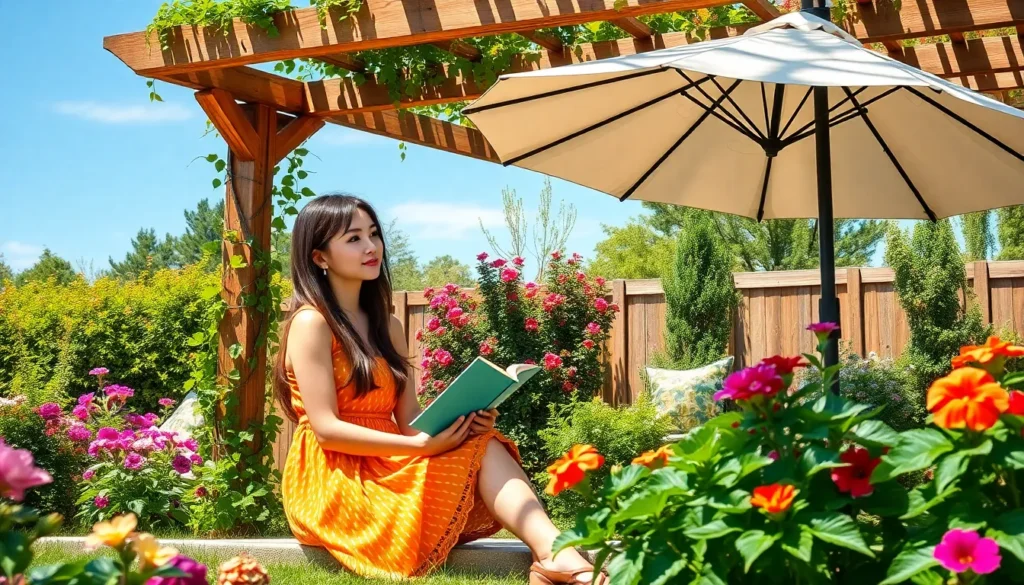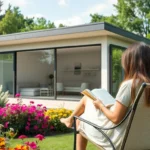We’ve all experienced that moment when our beautiful garden becomes unbearably hot during summer afternoons. The scorching sun can make outdoor spaces unusable and stress our precious plants beyond their limits. Creating effective shade in your garden isn’t just about comfort – it’s essential for protecting both you and your green investments.
Smart shade answers transform any outdoor space into a cool retreat. From natural options like strategically planted trees to creative structures like pergolas and shade sails, there are countless ways to beat the heat. We’ll explore budget-friendly DIY projects alongside more permanent installations that add both function and beauty to your industry.
Whether you’re dealing with a small patio or sprawling backyard, the right shade strategy can extend your outdoor living season and create comfortable microclimates for both people and plants. Let’s jump into proven techniques that’ll keep your garden cool and inviting all summer long.
Creative Shade Structures to Transform Your Garden Space
Beautiful shade structures serve as architectural focal points while delivering essential protection from intense sunlight. These permanent installations elevate your outdoor space beyond basic functionality.
Pergolas and Arbors for Natural Beauty
Pergolas create stunning overhead frameworks that blend seamlessly with garden landscapes. We recommend cedar or pressure-treated lumber for durability, with typical dimensions ranging from 8×10 feet to 12×16 feet for optimal coverage. Climbing vines like clematis, wisteria, or grape vines transform these structures into living shade canopies within 2-3 growing seasons.
Arbors offer intimate walkway coverage and serve as dramatic garden entrances. Most homeowners install 7-8 foot tall arbors with 4-6 foot widths to accommodate standard pathways. These smaller structures work perfectly for supporting roses, jasmine, or morning glories that provide seasonal shade variations.
Construction costs typically range from $1,200 to $4,500 for professionally built pergolas, while DIY kits start around $300. Installation takes 1-2 weekends for most homeowners with basic carpentry skills.
Gazebos for Complete Coverage
Gazebos deliver 360-degree shade protection with enclosed or semi-enclosed designs. We’ve found that 10×10 foot gazebos accommodate 6-8 people comfortably, while 12×12 foot models seat up to 10 guests for outdoor dining. Hardtop gazebos with metal or shingle roofs provide year-round weather resistance.
Screened gazebos offer additional protection from insects during summer evenings. Most models feature removable screen panels that adapt to seasonal needs. Popular materials include aluminum frames with powder-coated finishes that resist rust and fading for 15-20 years.
Pricing varies significantly based on materials and size, with basic pop-up canopy gazebos starting at $150 and permanent cedar structures reaching $8,000. Professional installation adds $500-1,500 to total project costs.
Shade Sails for Modern Appeal
Shade sails create dramatic triangular or rectangular canopies that complement contemporary garden designs. We recommend HDPE fabric with 185-340 GSM density for optimal sun protection and longevity. These materials block 85-95% of harmful UV rays while allowing air circulation.
Installation requires sturdy anchor points spaced 12-20 feet apart, including existing trees, fence posts, or dedicated steel poles. Proper tensioning prevents sagging and extends fabric life to 8-12 years. Most shade sails measure between 10×10 feet and 16×20 feet to cover standard patio areas.
Color options include neutral tones like sand, charcoal, and cream that coordinate with various architectural styles. Waterproof versions provide rain protection, while breathable fabrics offer better ventilation. Quality shade sails cost $75-400 depending on size and material grade.
Strategic Tree Planting for Long-Term Garden Shade
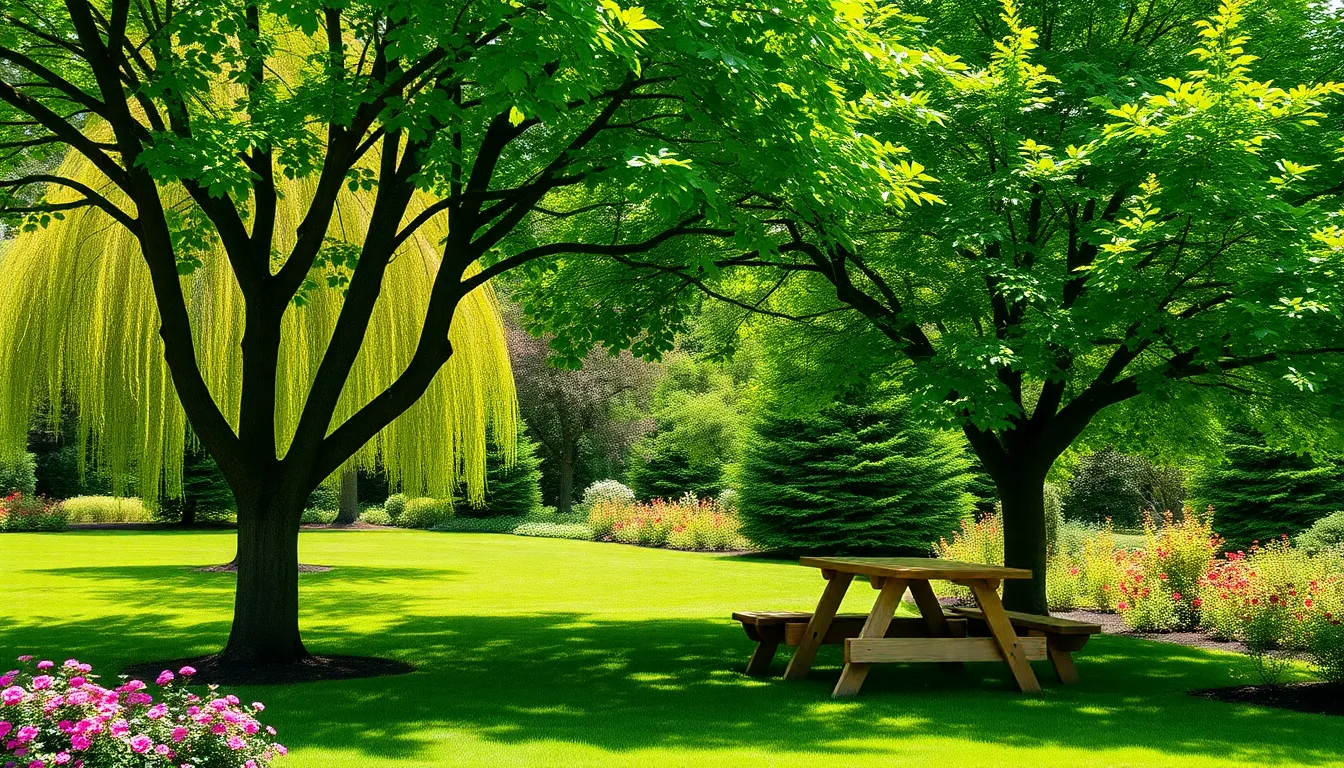
While temporary shade structures provide immediate relief, strategic tree planting offers the most sustainable solution for creating lasting garden shade. Trees not only absorb carbon dioxide and release oxygen to help mitigate climate change, but they also cool the environment, improve air quality, and conserve water naturally.
Fast-Growing Shade Trees to Consider
Willow trees stand out as champions of rapid growth, providing substantial shade coverage within just a few years of planting. These adaptable trees thrive in various soil conditions and can quickly transform sunny spaces into cool retreats.
Silver maple delivers impressive growth rates while adding substantial shade coverage to larger garden areas. This deciduous tree’s broad canopy develops rapidly, making it an excellent choice when you need shade sooner rather than later.
Red maple offers another fast-growing option that matures relatively quickly compared to traditional shade trees. Its vibrant seasonal color changes provide year-round visual interest while delivering the cooling benefits you’re seeking.
Hybrid poplar varieties can grow up to 8 feet per year, creating effective shade barriers in record time. These trees work particularly well for screening purposes while simultaneously providing overhead coverage.
Positioning Trees for Maximum Coverage
South and west facades receive the most intense sunlight throughout the day, making these areas prime locations for strategic tree placement. Planting trees on these sides of your house can block direct sunlight and reduce indoor temperatures significantly.
Seasonal considerations play a crucial role in tree positioning, as deciduous trees allow beneficial winter sunlight to reach your home while providing essential summer shade. This natural cycle helps reduce energy costs year-round without compromising winter warmth.
Sunlight pattern analysis helps determine optimal placement by observing how shadows move across your garden throughout different times of day. We recommend mapping these patterns during peak summer months to identify the most effective planting locations.
Distance calculations ensure trees provide maximum shade without interfering with structures or utilities. Plant large shade trees at least 20-30 feet from your home’s foundation to accommodate mature canopy spread.
Combining Fruit Trees with Shade Benefits
Apple and pear trees provide excellent dual-purpose answers, offering good shade coverage while yielding fresh fruit for your family. These productive trees create pleasant dining areas underneath their canopies during harvest season.
Fig and plum trees deliver both shade and bountiful harvests of delicious fruits throughout the growing season. Their dense foliage creates effective cooling while adding edible value to your industry investment.
Cherry trees combine beautiful spring blossoms with summer shade and sweet fruit production. These versatile trees work well as focal points in garden designs while serving multiple practical functions.
Citrus varieties thrive in warmer climates and provide year-round shade along with fresh fruit harvests. Lemon, lime, and orange trees create fragrant outdoor spaces while delivering consistent coverage in suitable growing zones.
Portable Shade Solutions for Flexible Garden Design
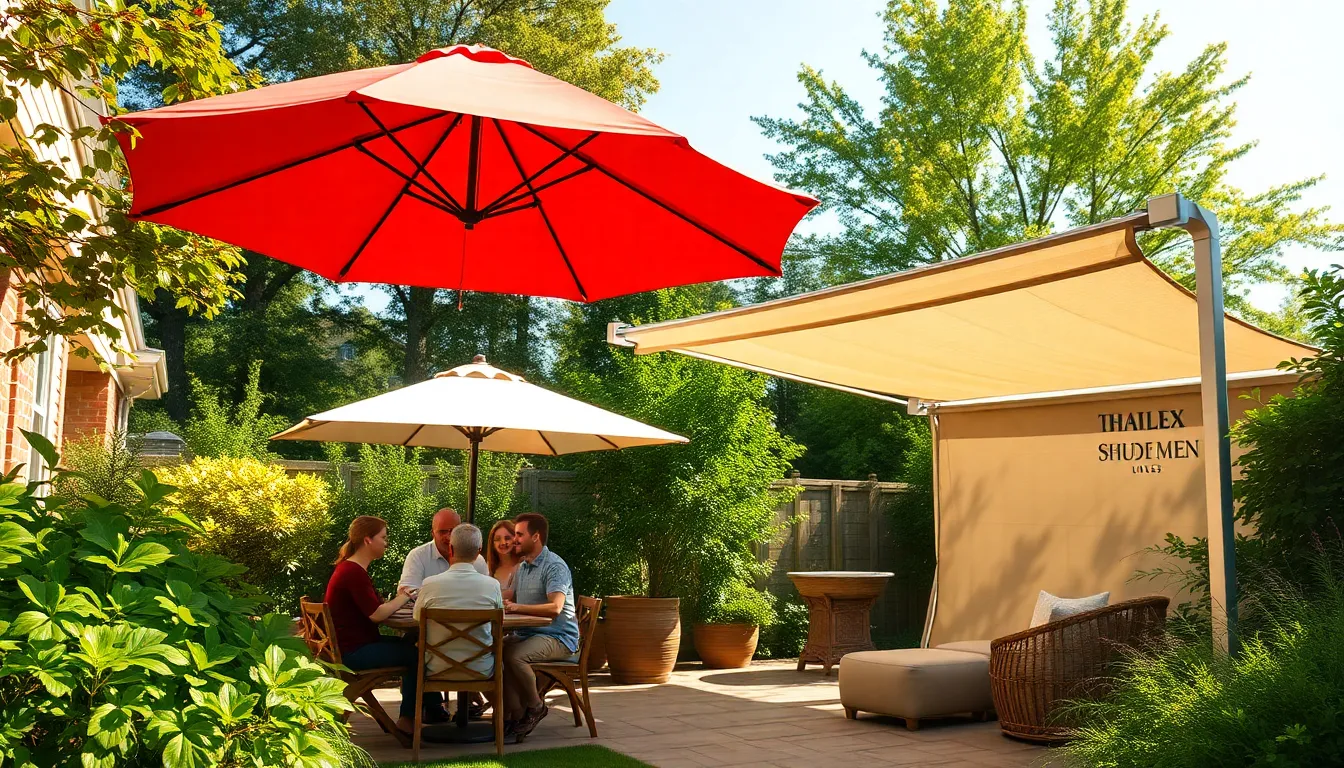
When you need shade answers that adapt to changing garden layouts and seasonal requirements, portable options offer unmatched versatility.
Market Umbrellas and Patio Umbrellas
Market umbrellas deliver budget-friendly shade that transforms any garden space instantly. We can choose from modern, striped, or bohemian styles to match different garden aesthetics perfectly.
Setting up these outdoor umbrellas requires minimal effort, and their lightweight design allows easy repositioning throughout the day. Moving them around the garden lets us follow shade patterns or accommodate different activities. Their affordability makes it possible to purchase multiple umbrellas for larger areas without important investment.
Anchoring options include weighted bases, ground stakes, or table inserts depending on your exact needs. Quality market umbrellas feature UV-resistant fabric and sturdy frames that withstand moderate wind conditions.
Pop-Up Canopies for Temporary Events
Pop-up canopies provide instant shade coverage for backyard parties and outdoor gatherings. We appreciate their quick setup process, which typically takes less than 10 minutes with two people. Taking them down proves equally simple when events conclude.
Adjustable height settings accommodate different space requirements and activity needs. These canopies work exceptionally well for temporary shade over dining areas, play zones, or entertainment spaces. Their portability means we can store them compactly when not in use.
Commercial-grade pop-up canopies offer superior durability compared to basic models, making them worthwhile investments for frequent outdoor entertaining. Weather-resistant materials ensure reliable performance across various conditions.
Rolling Shade Screens
Rolling shade screens create moveable barriers that block sun from exact directions. We can position these portable panels strategically to protect seating areas or sensitive plants throughout the day.
Portable shade panels function as temporary walls that redirect airflow while filtering harsh sunlight. Their lightweight construction allows one person to reposition them easily as sun angles change. These screens work particularly well for creating intimate spaces within larger garden areas.
Screen materials range from mesh fabrics that allow airflow to solid panels that provide complete sun blocking. Wheeled bases make transportation effortless across various garden surfaces including grass, gravel, and paving stones.
Living Shade Ideas Using Plants and Vines
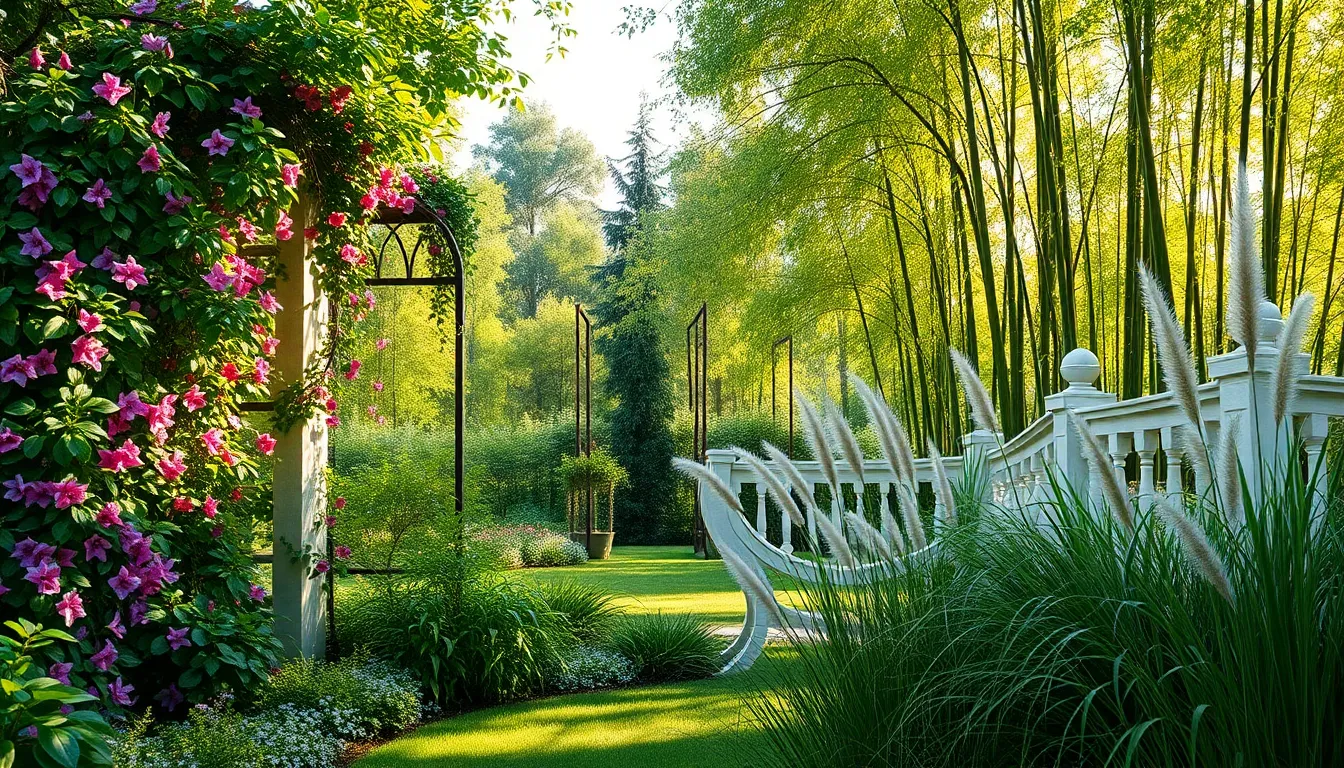
Plants and vines offer sustainable shade answers that grow more effective over time while adding natural beauty to our gardens.
Climbing Vines on Trellises
Clematis creates stunning vertical shade displays with vibrant flowers in various colors while thriving in partial shade conditions. This popular climbing vine reaches heights of 6 to 15 feet, making it perfect for covering pergolas and creating overhead canopies. We recommend planting clematis near seating areas where its colorful blooms can provide both shade and visual appeal.
Virginia Creeper adapts exceptionally well to different light conditions and grows rapidly up to 50 feet in length. This fast growing vine excels at covering large structures like gazebos, arbors, and extended trellis systems. We find it particularly effective for creating dense shade coverage over patios and outdoor dining spaces.
Honeysuckle produces fragrant flowers while growing 10 to 20 feet tall, offering versatile shade options for both sunny and shaded garden areas. This aromatic vine works beautifully on trellises positioned near windows and doorways. We appreciate how honeysuckle attracts beneficial pollinators while providing natural cooling.
Mandevilla thrives in partial shade environments and adds vibrant blooms to trellis structures throughout the growing season. This flowering vine creates attractive shade barriers when trained along pergola sides or fence lines. We recommend mandevilla for gardeners seeking colorful shade answers that perform well in filtered light conditions.
Trumpet Vine produces showy flowers while growing effectively on trellises in partial shade areas of the garden. This vigorous climber creates substantial overhead coverage when supported by sturdy trellis systems. We suggest trumpet vine for larger spaces where its bold growth habit can provide extensive shade coverage.
Tall Ornamental Grasses for Screening
Pampas Grass grows up to 10 feet tall and creates impressive natural screens that filter sunlight effectively. This dramatic grass type produces feathery plumes that add texture while blocking direct sun rays. We position pampas grass along property lines and around seating areas where its height provides both privacy and shade.
Fountain Grass reaches heights of 6 feet and offers decorative screening with its distinctive ornamental plumes. This attractive grass creates softer shade barriers compared to solid structures while maintaining visual interest. We plant fountain grass in clusters to maximize its screening potential and create graduated shade zones throughout the garden.
Bamboo Groves for Natural Privacy
Bamboo provides highly effective natural screens through its dense growth patterns that block both sunlight and unwanted views. Bamboo groves create substantial shade coverage while requiring minimal maintenance once established. We recommend bamboo for areas needing quick privacy answers since it grows rapidly and maintains year round coverage.
Dense bamboo plantings filter harsh afternoon sun while creating cool microclimates in garden spaces. This low maintenance screening option thrives in various growing conditions and provides consistent shade throughout the seasons. We suggest containing bamboo with root barriers to control its spread while maximizing its shade benefits in targeted areas.
DIY Garden Shade Projects on a Budget

Creating effective garden shade doesn’t require expensive installations or professional contractors. We can achieve excellent results using simple materials and basic construction techniques that fit any budget.
Canvas Drop Cloths as Temporary Shade
Canvas drop cloths offer one of the most affordable temporary shade answers for our gardens. We can easily hang these versatile materials from trees or between structures using simple ropes or clips for quick installation. Setting up this type of shade takes just minutes and provides immediate relief from harsh sunlight during small gatherings or outdoor events.
Tearing down canvas shade systems proves equally simple when we need to store them or change our garden layout. The lightweight nature of canvas makes it perfect for areas where we want flexible shade options that can be adjusted throughout the day. We can position multiple drop cloths at different angles to create custom shade patterns that follow the sun’s movement.
Repurposed Materials for Creative Answers
Repurposing materials like old pallets transforms discarded items into functional shade structures that cost almost nothing to create. We can stack pallets to form sturdy frames and cover them with fabric or translucent panels for effective shade coverage. This pallet canopy approach adds rustic charm to our outdoor spaces while providing practical sun protection.
Building with repurposed materials gives us complete creative control over the design and allows us to match existing garden aesthetics. We can paint pallets to coordinate with our outdoor furniture or leave them natural for an authentic weathered look. The modular nature of pallet construction means we can easily expand or reconfigure our shade structure as our needs change.
Simple Wooden Frame Constructions
Simple pergolas represent the most popular wooden shade structure we can build ourselves using basic carpentry skills. We can construct a basic 12×12 feet pergola using durable cedar or redwood lumber that will last for many seasons. Adding cloth coverings or training climbing plants over the frame provides additional shade while creating an attractive garden focal point.
Building a picnic table pergola attached to our house wall costs around $200 in materials and provides targeted shade for dining areas. We can customize the dimensions to fit our exact space requirements and add features like built in benches or planters. Installing shade sails between cedar posts using coated cables creates a modern alternative that fits any garden space with stylish appeal and easy maintenance.
Creating DIY canopies using simple wooden frames and fabric offers more permanent shade answers for our outdoor seating areas. We can design these structures to complement our home’s architecture while providing reliable protection from sun and light rain.
Shade Ideas for Specific Garden Areas
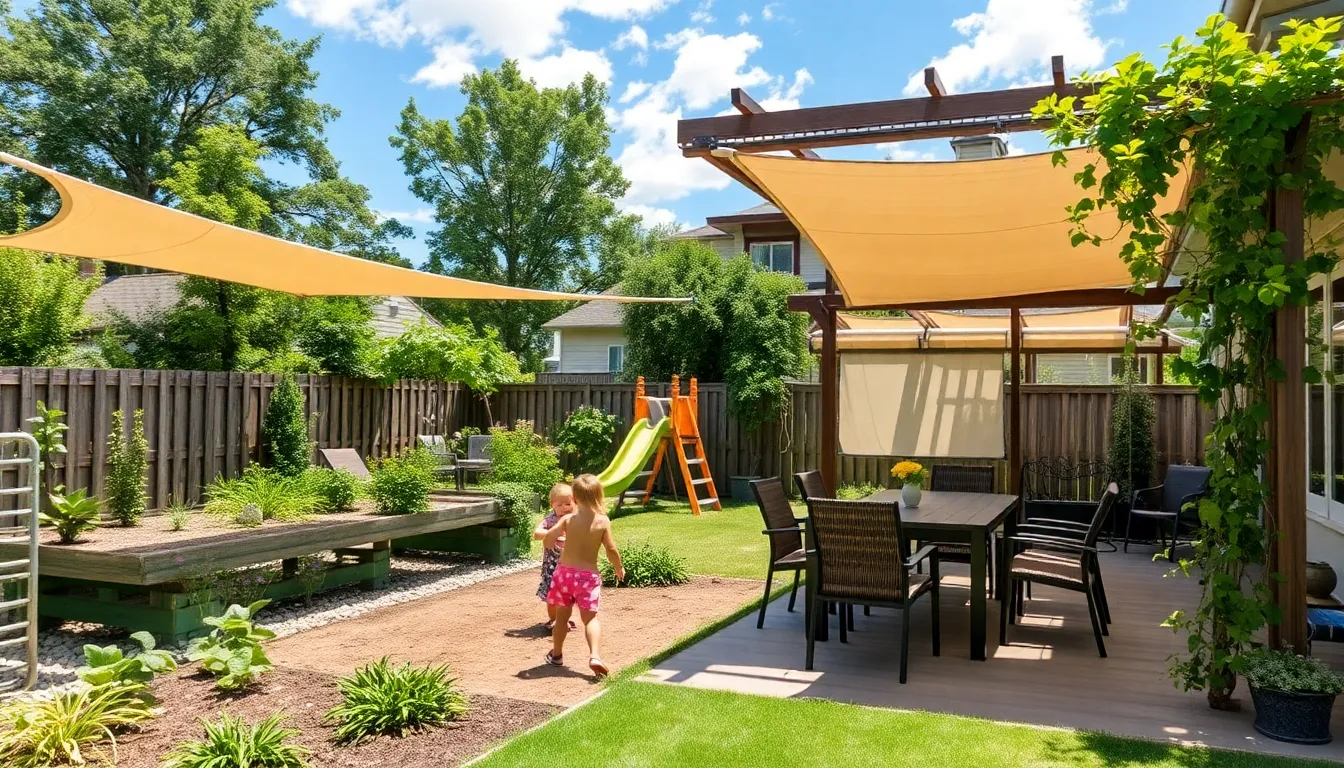
Creating targeted shade answers enhances both functionality and comfort in distinct outdoor spaces. We’ll explore customized approaches that address the unique needs of your garden’s most important areas.
Vegetable Garden Protection
Shade cloth installation provides essential protection for heat-sensitive vegetables during scorching summer months. We recommend using 30% to 50% shade cloth to filter harsh sunlight while maintaining adequate growing conditions for crops like lettuce, spinach, and herbs. Position the cloth 12 to 18 inches above plants to prevent moisture accumulation and ensure proper air circulation.
DIY shade answers offer budget-friendly alternatives using readily available materials. Old bedsheets, floating row covers, or lattice panels can create effective temporary protection for young seedlings and delicate plants. These materials work particularly well when stretched between garden stakes or tomato cages to form protective tunnels.
Shade hoop construction delivers flexible coverage that adapts to your garden’s changing needs throughout the growing season. Build these structures using PVC pipes bent into arches and covered with shade cloth or lightweight fabric. This method allows easy adjustment and removal when plants no longer require protection.
Children’s Play Area Coverage
Permanent shade structures transform outdoor play spaces into comfortable year-round environments. Gazebos with solid roofs provide reliable 360-degree protection from both sun and rain, while pergolas offer partial shade that can be enhanced with climbing vines or retractable fabric panels. These installations typically cost between $1,500 to $5,000 depending on size and materials.
Portable canopy options deliver flexibility for families who need adaptable shade answers. Collapsible pop-up canopies can be repositioned throughout the day to follow optimal shade patterns, while large patio umbrellas offer quick setup and takedown for seasonal use. These options range from $50 to $300 and work well for temporary playground coverage.
Safety considerations remain paramount when designing children’s shade areas. Ensure all structures have rounded edges, secure anchoring systems, and adequate clearance around play equipment. Fabric panels should be UV-resistant and properly tensioned to prevent sagging or tearing during active play.
Outdoor Dining and Entertainment Spaces
Pergola installations create sophisticated dining environments that blend functionality with architectural appeal. Train climbing vines like grape, wisteria, or jasmine across the top beams for natural shade, or install retractable fabric panels for instant coverage control. Professional installations typically range from $2,000 to $8,000 depending on size and material quality.
Retractable awning systems offer premium shade answers for entertaining spaces that require weather adaptability. These motorized or manual systems extend over patios and decks to provide instant coverage, then retract completely when full sunlight is desired. Quality retractable awnings cost between $1,200 to $4,000 and significantly extend outdoor dining seasons.
Umbrella and canopy arrangements provide versatile shade for intimate gatherings and larger celebrations. Large market umbrellas with 9 to 11-foot diameters effectively cover standard dining tables, while multiple smaller umbrellas can create ever-changing shade patterns across expansive entertaining areas. Cantilever umbrellas eliminate center posts for unobstructed table arrangements and enhanced guest comfort.
Combining Shade with Garden Functionality
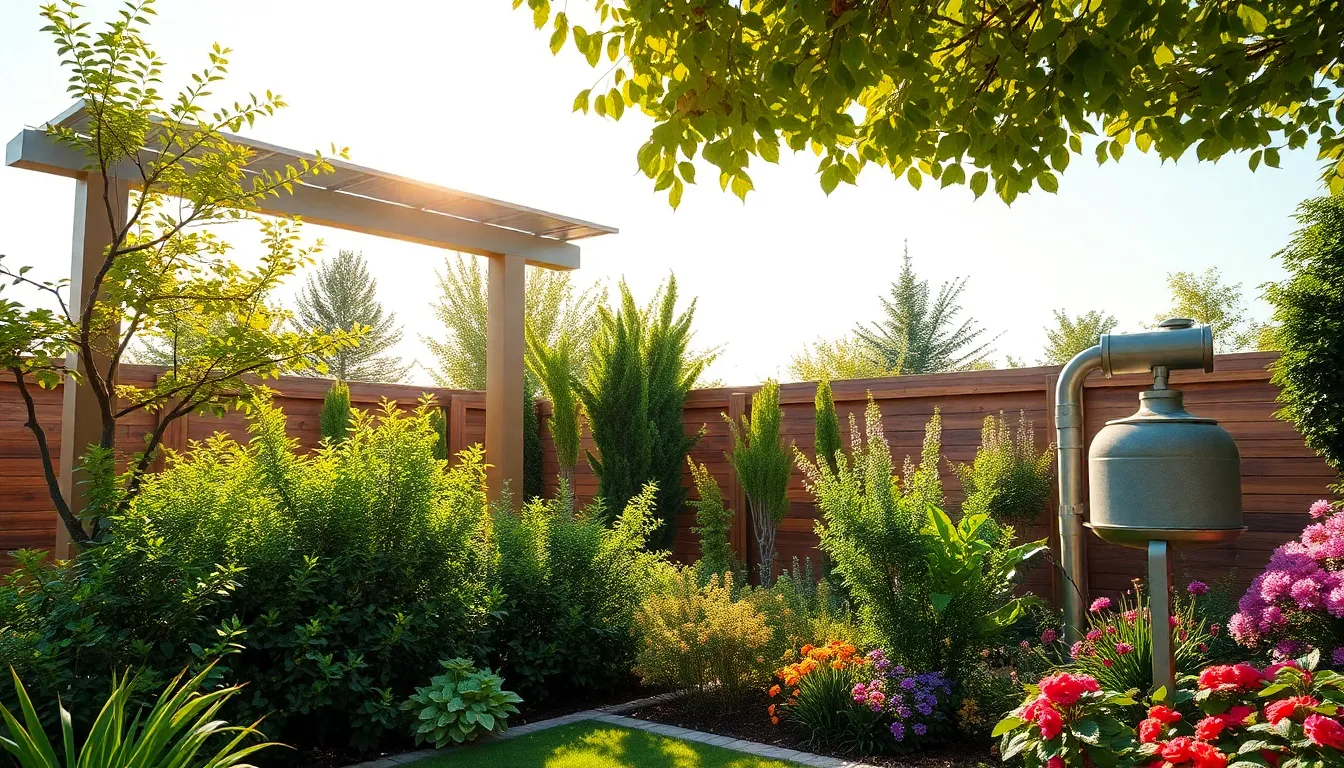
We can maximize our garden’s potential by incorporating shade elements that serve multiple purposes beyond simple sun protection. Smart shade answers enhance our outdoor spaces while providing additional functionality like energy generation, water conservation, and improved plant growing conditions.
Rainwater Collection Integration
Rain collection systems work beautifully when integrated into our shade structures, creating sustainable water management answers. We can position rain barrels strategically under pergola downspouts or arbor drainage points to capture valuable precipitation while maintaining our shade coverage. Garden fountains and decorative ponds serve dual purposes by collecting rainwater runoff from nearby shade structures while adding aesthetic appeal to our shaded areas.
Installing rain chains beneath pergolas creates an attractive water feature that channels rainwater from roof surfaces directly into collection containers below. We can also incorporate rain gardens around shade structures, allowing natural runoff to water drought-tolerant plants while reducing irrigation needs. These integrated systems help us conserve water resources while improving the visual interest of our shaded garden spaces.
Solar Panel Shade Structures
Solar panels transform ordinary shade structures into energy-generating powerhouses that reduce our carbon footprint while providing essential sun protection. We can install photovoltaic panels as roofing material for pergolas, gazebos, or custom shade structures, creating clean electricity while maintaining comfortable outdoor living areas. These installations typically generate 250-400 watts per panel, helping offset household energy consumption.
Modern solar pergolas can power outdoor lighting, water features, or even contribute to our home’s electrical grid through net metering programs. We should consider factors like roof pitch, orientation, and local sun exposure when designing solar shade structures to maximize both energy production and shade effectiveness. Professional installation costs range from $15,000 to $25,000 for solar pergolas, though federal tax credits and local incentives can significantly reduce these expenses.
Multi-Level Garden Design with Shade
Tiered garden designs create diverse microclimates by strategically layering shade-providing elements at different heights and locations. We can establish tall shade trees as the upper canopy, medium-height shrubs as the middle layer, and ground-level plantings to create natural cooling zones throughout our garden space. Each level receives optimized sunlight exposure while contributing to the overall shade system.
Strategic placement of trellises, arbors, and climbing structures at various elevations helps us maximize vertical growing space while creating graduated shade patterns. We can plant heat-sensitive vegetables and flowers in lower tiers where they receive filtered light, while sun-loving plants thrive in higher, more exposed areas. This approach allows us to grow diverse plant varieties within the same garden footprint while maintaining comfortable microclimates for both plants and people.
Conclusion
Creating effective garden shade doesn’t have to be complicated or expensive. We’ve explored many answers from quick DIY projects using canvas and repurposed materials to more permanent installations like pergolas and strategic tree plantings.
The key is choosing shade answers that match your exact needs and garden layout. Whether you’re protecting vegetables with shade cloth or creating comfortable entertainment spaces with retractable awnings each approach offers unique benefits.
Remember that the best shade strategies often combine multiple elements. Pairing fast-growing trees with portable umbrellas or integrating rainwater collection into pergola designs maximizes both functionality and sustainability.
Start with one shade project that addresses your most pressing need then gradually expand your garden’s shade coverage. With these diverse options you’ll create comfortable outdoor spaces that work for every season and situation.
Frequently Asked Questions
What are the best fast-growing trees for garden shade?
Willow, silver maple, red maple, and hybrid poplar are excellent fast-growing shade trees that can provide substantial coverage quickly. These trees can grow several feet per year and establish effective shade in just a few seasons. Consider your climate zone and soil conditions when selecting the best option for your garden.
How much does it cost to build a pergola for shade?
Professional pergola installation typically costs between $2,000-$6,000, depending on size and materials. DIY pergola kits range from $300-$1,500, offering significant savings. Wood pergolas are more affordable, while composite materials cost more but require less maintenance. Consider your budget and skill level when choosing between professional and DIY options.
What percentage of shade cloth should I use for vegetables?
Use 30% to 50% shade cloth for most heat-sensitive vegetables like lettuce, spinach, and herbs. This provides adequate protection from intense sunlight while maintaining sufficient light for photosynthesis. Ensure proper air circulation around the cloth to prevent heat buildup and maintain healthy growing conditions for your plants.
Are shade sails effective for UV protection?
Yes, quality shade sails can block 90-95% of harmful UV rays while providing excellent coverage. They’re particularly effective when made from high-density polyethylene fabric with UV-resistant treatments. Proper installation with adequate tension and secure anchor points ensures maximum effectiveness and longevity of the shade sail system.
What are the most budget-friendly DIY shade solutions?
Canvas drop cloths, repurposed pallets, and old bedsheets are among the most affordable DIY shade options. Canvas drop cloths cost $20-$50 and can be easily hung between posts. Pallet structures require minimal investment beyond basic hardware. These solutions offer temporary to semi-permanent shade at a fraction of commercial structure costs.
How do I position trees for maximum shade effectiveness?
Plant shade trees on the south and west sides of your property to block the most intense afternoon sun. Consider the mature size and canopy spread when positioning trees. Analyze seasonal sun patterns and place trees where they’ll provide shade during the hottest parts of the day while avoiding interference with desired sunlight areas.
What climbing vines provide the best shade coverage?
Virginia creeper, clematis, honeysuckle, and trumpet vine are excellent choices for shade coverage. Virginia creeper grows rapidly and provides dense coverage, while clematis offers beautiful flowers. Honeysuckle provides fragrant blooms and attracts beneficial insects. Choose based on your climate, support structure, and desired aesthetic appeal.
Can I combine fruit trees with shade gardening?
Absolutely! Apple, pear, fig, plum, cherry, and citrus trees provide excellent shade while producing fresh fruit. These dual-purpose trees enhance both aesthetic and functional value of your garden. Consider mature size, local climate compatibility, and pollination requirements when selecting fruit trees for shade purposes.
What portable shade options work best for changing garden layouts?
Market umbrellas, pop-up canopies, and rolling shade screens offer excellent flexibility for changing garden needs. Umbrellas can be easily repositioned throughout the day, canopies provide quick temporary coverage for events, and rolling screens create movable barriers. These options allow you to adapt shade coverage as your garden evolves.
How can I integrate sustainability into my shade structures?
Install rainwater collection systems on pergolas and gazebos to capture water for irrigation. Add solar panels to shade structures to generate renewable energy while providing coverage. Create multi-level gardens with layered shade elements to optimize growing conditions for various plants while maximizing space efficiency and environmental benefits.

